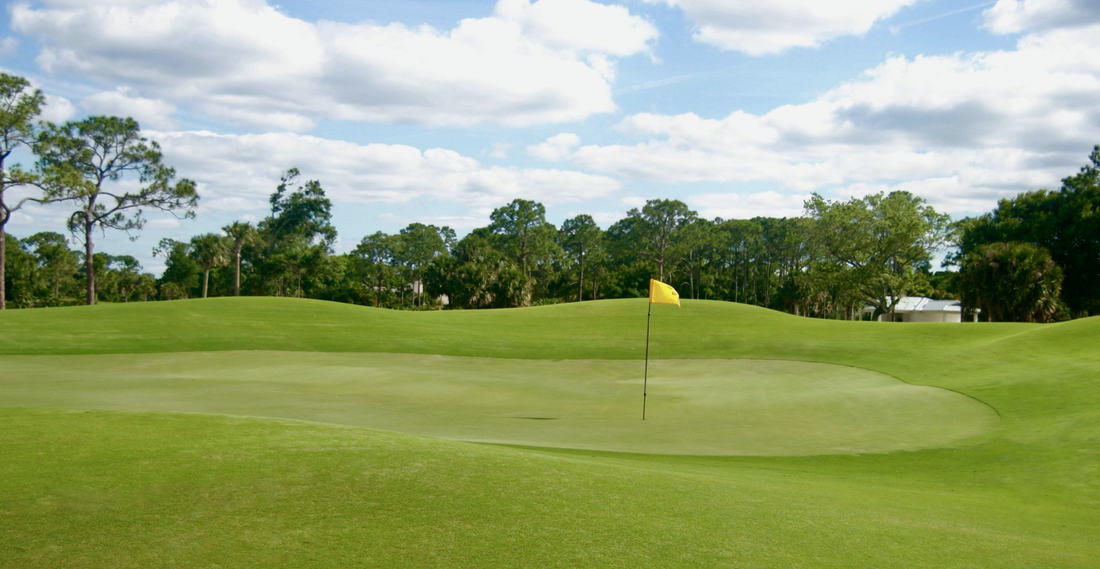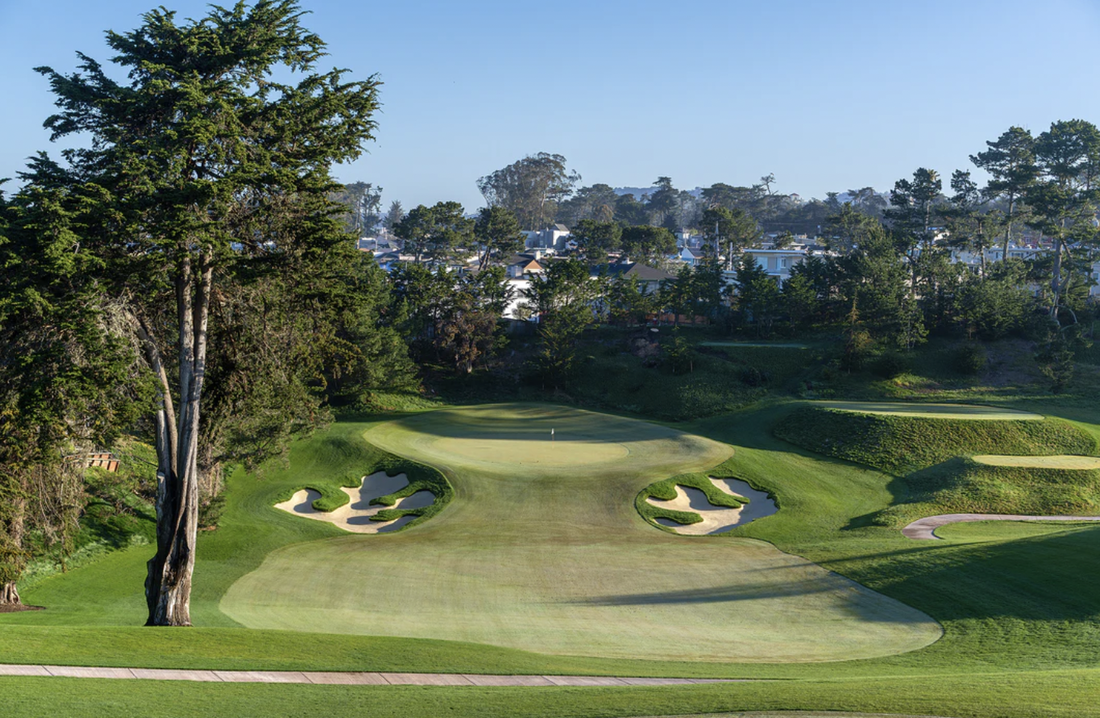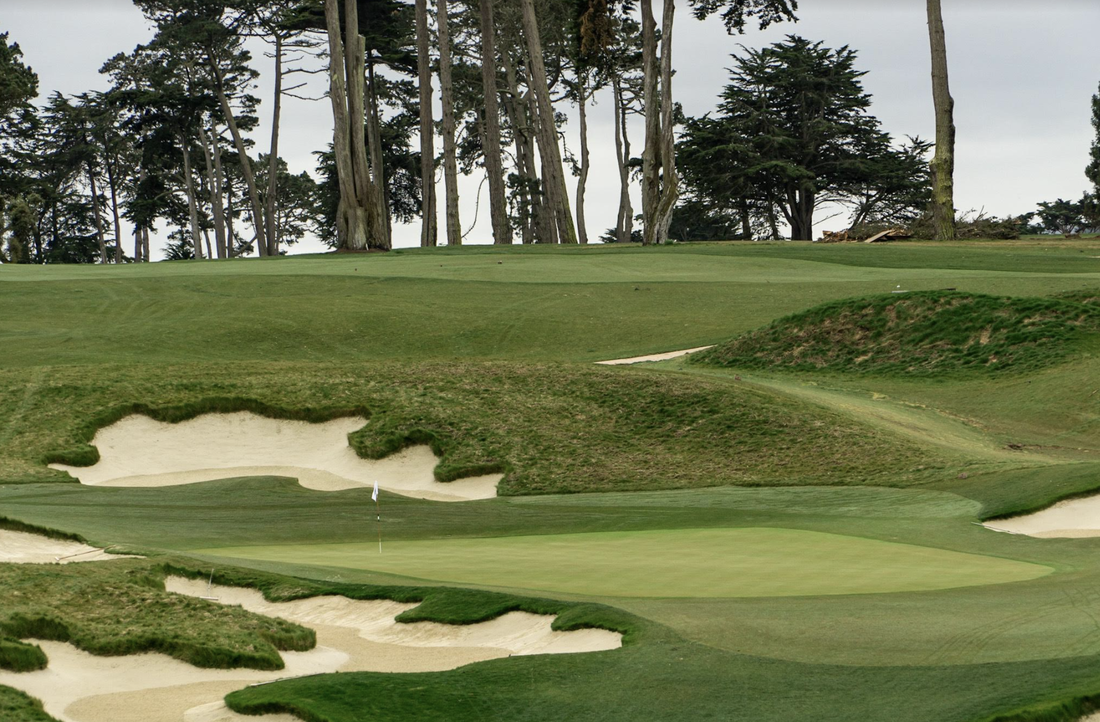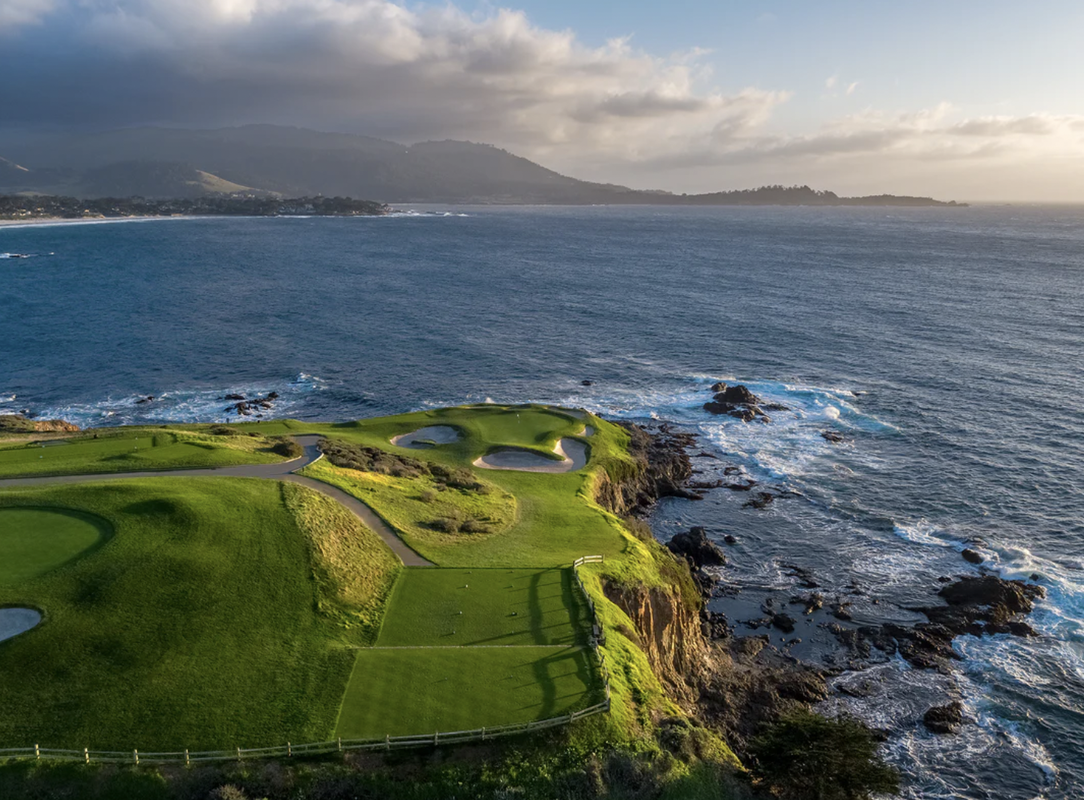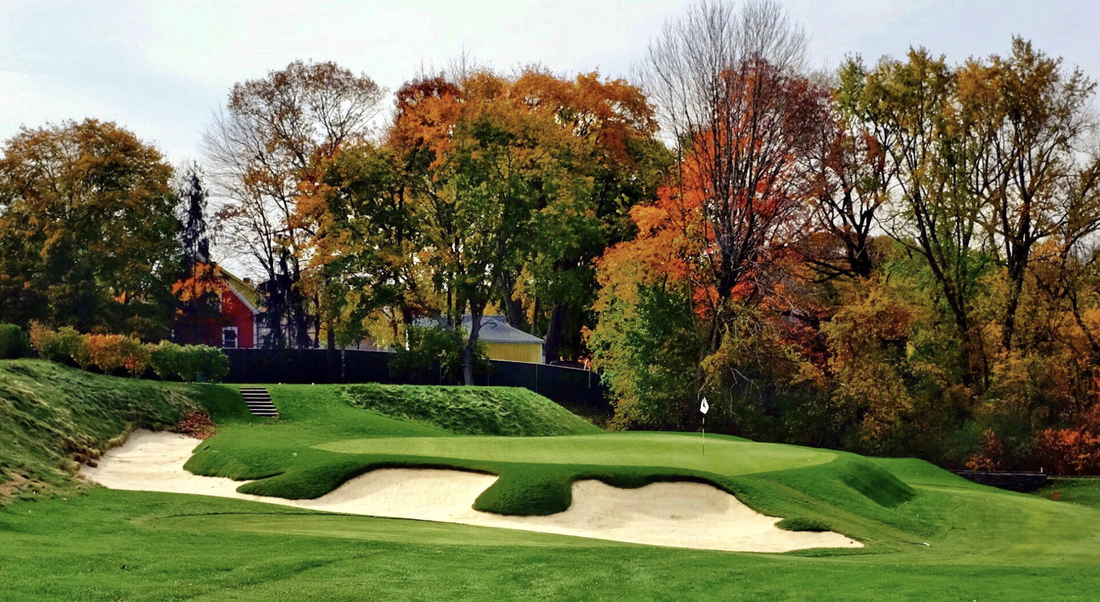|
Alex Elias Formerly a 1989 Arthur Hills-designed course, The Match at Jonathan’s Landing Golf Club, designed by Gil Hanse and Jim Wagner, strays away from the normal Florida golf experience. Jared Werner, Head Golf Professional at Jonathan’s Landing Golf Club, said, “It really is different because the course doesn’t have any properties in between the holes, which you would normally find on a South Florida course.” As the property has the benefit of the fairways not being lined with houses, much of the water is on the edge of the property as well, allowing for Hanse and Wagner’s distinctive bunkers to come into play on more than one hole, as such on No. 1 and No. 18 and No. 3 and No. 12. Ben Spector, Assistant Golf Professional at Jonathan’s Landing Golf Club, said, “The layout is so different than the typical Florida course because at most other courses you can’t see the next hole. Here, Hanse’s design ties the holes together tremendously.” As a compliment to the open playing corridors, Hanse and Wagner designed a varied set of greens, including the punchbowl third, the long and narrow fourth, and "Dustpan" seventh, among many more.
“The greens are the defense of the golf course,” said Werner. "Hanse and Wagner give the golfer options, requiring players to commit to their shot selection. With certain hole locations, golfers are required to play away from the flag and allow the contours of the green to bring the ball closer to the hole." Designed with match play in mind, Werner said, “The design forces players to decide how aggressive they want to be and opens up the possibility for every club in the bag to be used.” Referencing the Par-5 2nd in particular, which he referred to as, “the prettiest hole on the course,” Werner said, “With a large water hazard along its right side, No. 2 challenges you to decide how aggressive you want to be off the tee in order to be gain a better angle to a green that from back to front is very narrow and features a false front.” The Par-4 13th is perhaps the most evident example of the risk/reward on The Match. A 298 yard drivable Par-4, the slightly elevated and severely contoured green is protected by one greenside bunker and five bunkers sixty yards short. Spector said, “When you’re standing on the tee, you think it’s an easy hole but if you carry it even slightly long, a short chip can quickly go off the green. I’ve made an eagle, birdie a handful of times, and probably bogey more that I’ve made par.” In transforming a relatively flat and monotonous design, Hanse and Wagner vastly delivered in designing a unique, challenging, and enjoyable course that has cemented The Match at Jonathan’s Landing Golf Club as one of top courses in the Palm Beach/Jupiter area.
0 Comments
Alex Elias Founded in 1897, Belleair Country Club is the oldest club in Florida. Originally a six-hole course, the West Golf Course expanded to eighteen holes in 1909. In 1915, Donald Ross redesigned the West Golf Course, while adding the East Golf Course. Less than a decade later, in 1924, Ross returned and revised both courses based on another decade of experience designing courses across the U.S. In 2020, Belleair Country Club hired Fry/Straka Global Golf Course Design to oversee the restoration of the West Golf Course. To restore the course to Ross’ 1924 design, Jason Straka turned to historical records stored at the Tufts Archives at Pinehurst Resort (Pinehurst, North Carolina) and The Bellview Inn (Belleair, Florida). "The vast bulk of the work we did at Belleair was to undo what had been done over the past sixty years," said Straka. "Through previous rebuilds, where the greens had been built on top of the previous greens, rather than having been removed and rebuilt at the same grade, and decades of top-dressing, the greens had been raised significantly – five, six, seven feet in the air, even more in some cases. As a result, there was a big misconception that Ross' greens were inverted saucers, but that couldn’t be anything further from the truth." As the greens had drastically strayed from Ross' vision, the green on the Par-3 4th had been pushed up several feet, with runoffs in all directions, to where if you stood on the tee, you couldn't see the Intracoastal Waterway behind the green. Restored to Ross' design, No. 4 now plays slightly downhill to island green surrounded almost entirely by sand. Jim Slattery, Director of Golf at Belleair Country Club, described the Par-3 as "incredibly restored" and "absolutely beautiful." "Not only does the green now sit down, offering a view of the water, but it appears as if the water is directly behind it, when in fact there’s two fairways between the green and the water," said Slattery. The fourteenth green was perhaps the most dramatic. Straka said, "As we reviewed Ross' notes, Ross had a four-foot backsplash on the fourteenth green, where if you hit it slightly long, the ball would feed back towards the center of the green, but when we stood there, the green was built up like a volcano, falling away on each side." "When we started lowering the fourteenth green, we went through the layers of the old greens, like a birthday cake. On most greens, we knew when we got down to the original grade because the surrounding grade was tied in better, but on the fourteenth we hit the old railroad bed, which Ross had built the green on," said Straka. Straka’s restoration of Ross’ cop mounds, “inverted bunkers,” and streams, which come into play on eleven of the eighteen holes, had an immense effect on restoring the course to how Ross intended for it to be played. Referencing No. 3, which Straka admitted, "was painstakingly restored to Ross’ design," Slattery said, "The strategy has really come back to life." "With the return of the cop mounds and streams, you can really see how brilliant Ross was. Members would tend to hit away from the stream, but with the return of the cop mounds, players are forced back towards the center, bringing the stream into play. On No. 3 especially, but really throughout the entire course, players now have to think about the risk/reward much more on the tee," said Slattery. In all, Straka restored seventeen holes and replaced an existing Par-3 with the Par-3 7th. The downhill Par-3 7th plays to a peninsula green that extends into the Intracoastal Waterway. Although there was some hesitancy to design a new hole, Straka said, "The consensus was that if Ross had had access to the land, then he would have used it,” as at the time the peninsula was owned by the town of Belleair.
As No. 7 is as picturesque as any Par-3, Slattery said, "If you hit it short, long, or right, you're in the water, and if you hit it left, you're in a bunker, and possibly cop mounds. It's a demanding hole, but the view trumps even the difficulty of it." Alex Elias Five months after hosting The ANNIKA driven by Gainbridge at Pelican for the fourth consecutive year, Pelican Golf Club is set to host the 2024 SEC Women’s Golf Championship. As Pelican Golf Club has cemented themselves as an ambassador for women’s golf, Justin Sheehan, Director of Golf at Pelican Golf Club, said, “It means so much to us to be hosting the women. From Day 1, the Doyle family (Founders of Pelican Golf Club) wanted the golf world to see this isn’t a club just for men.”
“There’s something incredibly special about the women’s game,” said Sheehan. “It’s under appreciated and important to keep supporting it.” Heading into the 2024 SEC Women’s Golf Championship, eight of the fourteen SEC teams rank inside the Top 20. Angelica Moresco, former Alabama women’s golfer, said, “The SEC is one of the strongest, if not the strongest conference in the country. It’s where you find yourself competing against the best amateurs in the world. If you can win an SEC Championship, then you have reached the highest level of Division 1 golf.” Within the field, five SEC players are on the 2024 Annika Award Spring Watch List: Maisie Filler (Florida), Maria Jose Marin (Arkansas), Ingrid Lindblad (LSU), Caitlyn Macnab (Ole Miss), and Louise Rydqvist (South Carolina). Speaking of not only the players on the Spring Watch List, but the talent throughout the entire conference, Sheehan said, “They don’t have any weaknesses.” “The composure that these young women have is so impressive. They’re so level headed,” said Sheehan. “Many of the best players don’t excel because they have certain physical traits that are substantially better, but rather because they understand how to play golf.” A second-shot golf course with firm and challenging green complexes, Sheehan said, “The ability to manage the green complexes will be key, but with multiple long Par-4s on the course, whoever can hit some long, high 180-yard shots into the greens will separate themselves.” Alex Elias Originally designed in 1923 by Willie Lock, Lake Merced Golf Club was renovated shortly thereafter by Alister MacKenzie in 1929. In the decades following, the construction of a freeway forced Robert Muir Graves to re-route the course in 1962, and in 1996, Rees Jones led a renovation on the greens and bunkers. In 2020, Lake Merced hired Hanse Golf Course Design to renovate the course. Initially brought in to achieve Lake Merced’s objectives, architect Gil Hanse and partner Jim Wagner presented a plan to restore the course to MacKenzie’s design. Pat Steffes, Head Golf Professional at Lake Merced Golf Club, said, “The impetus was we needed to update the greens, bunkers, and irrigation, and possibly re-locate the driving range, but when Gil arrived, he was immediately confident that we could restore the vast majority of MacKenzie’s original design.” Steffes continued, “That was the big transition in the renovation. The scope became much bigger – every hole would be completely changed and the range would move across the property.” In all, Hanse and Wagner rebuilt 18 greens, refurbished 150,000 square feet of bunkering, restored and expanded every tee complex, moved the practice facility from one side of the property to the opposite and installed new irrigation. Steffes said, “Fourteen of the holes were restored to MacKenzie’s original design as Hanse worked mainly off a 1938 aerial photo, three were sympathetic to the original design, for example, the current 17th is similar to MacKenzie’s 18th, but the bunkers are now on the left, and were on the right previously, and Hanse designed one new hole – the 16th.” The Northwest corner of the course experienced the most significant changes, including the Par-4 12th and Par-3 13th. Noting No. 12 as his favorite hole on the course, Steffes said, “It’s a golf hole you don’t see many places, especially in our area. It’s a 476 yard Par-4, that plays shorter, but you’re still going to have a decent club in, hitting downhill to a punchbowl green, fairway-cut around it with tremendous bunkering. It’s just a really unique hole that Gil was able to recapture.” “Immediately after, you play the Par-3 13th, which to determine the scale, Gil estimated the shoulder width of people standing next to one other in an old photo,” said Steffes. “The bunkering is incredible. It’s a pretty simple hole at only 150 yards from the back tee, but it’s a little scary when you stand on the tee. There are bunkers that shouldn’t be in play, but you’re thinking about them as you’re hitting.”
As Steffes alluded to the deceptive bunkering on No. 13, MacKenzie’s deceptive bunkering has been restored throughout the course. Steffes said, “When you view the course now, you know it’s the course that was meant to be played. You see MacKenzie’s style.” Steffes continued, “One feature is his deceptive bunkering, where a bunker is off set from the green, but appears as if it’s greenside. No. 1 is a great example. The bunkers are twenty-five yards short, but if you’re playing the hole for the first time, you would think they were greenside.” Comparing the course post-renovation, Steffes said, “The old design was very one dimensional. It didn’t demand nearly the same creativity. You now have three shots you can hit into basically any green. You can putt, bump it, or fly it, and you can utilize more of the short grass countours.” As Lake Merced re-opened in 2022, Steffes said, “The foresight of Gil and the membership to go ahead and commit to something like this can’t be overlooked. We are incredibly proud of our MacKenzie lineage and to have brought back the history is very unique. A lot of places either can’t do it or don’t get the opportunity to.” Alex Elias George Herbert Walker, maternal grandfather of President George H.W. Bush and great-grandfather of President George W. Bush, was the President of the United States Golf Association (USGA) in 1920. In 1922, Walker was the driving force behind the inaugural Walker Cup (a biennial amateur golf match contested by 10-man teams from the United States of America and Great Britain & Ireland) at National Golf Links of America.
Although Walker's profound impact is the most noteworthy of the lineage, George H.W. Bush's grandfather, Samuel Prescott Bush, was one of the four founding members of Scioto Country Club and his father, Prescott Samuel Bush was a member of the Yale University golf team and a one-time USGA president (1935). Remarkably, even with his relatives' many historic achievements, George H.W. Bush is the only member of the Bush family to have been named the recipient of the Bob Jones Award (2008), the highest honor bestowed by the USGA, as well been inducted into the World Golf Hall of Fame (2011). As golf has always been a central pillar of the Bush family, two notable clubs were at the forefront of George and Barbara Bush's marriage. First, in 1941, 18-year-old George H.W. Bush met 16-year old Barbara Pierce at Round Hill Club. Then, in 1945, the two were married at the First Presbyterian Church in Rye, New York, followed by a reception at Apawamis Club. It was at Cape Arundel Golf Club that George H.W. Bush and George W. Bush learned the game. Today, the Clubhouse is named "41 House" in honor of the 41st President of the United States, and the Club’s Practice & Teaching Facility is named "43 House" in honor of the 43rd President of the United States. Alex Elias Camargo Club - Cincinnati, Ohio Seth Raynor Designed by Seth Raynor in 1925, Camargo Club features the Eden 5th, the Biarritz 8th, the Short 11th, and the Redan 15th. As Raynor designed several courses that could vie for the best set of Par-3s, Pete Dye declared Camargo's the finest. Notably, many believe the Eden at Camargo Club to be the best rendition of the template. Chicago Golf Club - Wheaton, Illinois C.B. Macdonald/Seth Raynor In 1908, C.B. Macdonald designed National Golf Links of America, with the goal to create "the perfect golf course." Macdonald's design featured 'Short,' 'Eden,' and 'Redan', but it was at Piping Rock Club, not National Golf Links of America, where Macdonald first introduced 'Biarritz', becoming the standard quartet of template one-shot holes for Seth Raynor. In 1925, Raynor added the Biarritz 3rd, the Redan 7th, the Short 10th, and the Eden 13th to Chicago Golf Club. Notably, many believe the Redan at Chicago Golf Club to the best rendition of the template. Cypress Point Club - Pebble Beach, California Alister MacKenzie No. 15 and No. 16 are two of the most breathtaking holes in the world. From tee boxes perched 60 feet above a cove, No. 15 and No. 16 vary drastically in length. No. 15 is one of the best short Par-3s in America, playing no more than 140 yards, while No. 16 plays 233 yards from the tips. In fact, Alister MacKenzie contemplated making No. 16 a drivable Par-4. Although No. 15 and No. 16 receive the highest praise, and rightfully so, the 157 yard Par-3 3rd and 170 yard Par-3 7th are excellent in and of themselves. Los Angeles Country Club (North) - Los Angeles, California George C. Thomas Jr. Designed by George C. Thomas, Los Angeles Country Club (North) was restored in 2010 by Gil Hanse, his associate Jim Wagner and their colleague Geoff Shackelford. In an interview with The Fried Egg, Shackelford said, "I think LA North has the best set of Par-3s on the planet." With five distinct Par-3s, the 11th can stretch to nearly 300 yards, while the 15th often plays just 90 yards. Pine Valley Golf Club - Pine Valley, New Jersey George Crump/H.S. Colt Each hole at Pine Valley Golf Club is incredibly distinct, and the Par-3s are no exception. The demanding, uphill 238 yard Par-3 5th requires players to carry a water hazard, cross-bunker, and avoid deep bunkers left and right. As No. 5 is certainly the most demanding, each Par-3 poses a challenge in variety and strategy. Sleepy Hollow Country Club - Briarcliff Manor, New York C.B. Macdonald/A.W. Tillinghast The 149 yard Par-3 16th may be the most picturesque hole on the East Coast. Set in front of the Hudson River, the green features a thumbprint and is protected by a trench bunker that wraps around nearly the entire green. As No. 16 is the last of four Par-3s, players are greeted earlier in the round with No. 3, a 172 yard Par-3 over a ravine, No. 7, one of the best Reverse Redans in the country, and No. 10, a 168 yard Par-3 over water. Somerset Hills Country Club - Bernardsville, New Jersey
A.W. Tillinghast A.W. Tillinghast's Redan at Somerset Hills Country Club may be the best rendition in the world. From an elevated tee, the 201 yard Par-3 2nd requires a tee shot to the right side, as the green is set superbly over the terrain and severely sloped, with the bulk of the green hidden. By the Par-3 12th, if Somerset Hills hasn't already left a lasting impression, the setting of the beautiful Par-3 will certainly cement the Tillinghast gem as a favorite course.
Alex Elias
Boston Golf Club - Hingham, Massachusetts
Designed by Gil Hanse, the opening Par-5 at Boston Golf Club plays 510 yards from the Championship tees and 475 yards from the Member tees, featuring a blind tee shot off the tee and an elevated green. If one decides to go for the green in two, one will have an uphill shot off a downhill lie.
Castle Pines Golf Club - Castle Rock, Colorado
Although the listed yardage is 644 yards from the International tees and 600 yards from the Combo tees, the opening Par-5 at Castle Pines Golf Club can be comfortably reached in two, as No. 1 plays downhill at 6,220 feet.
Erin Hills - Erin, Wisconsin
Routed around a wetland on the left, the green of the 553 yard opening Par-5 is fairly accessible as the fairway feeds into the green and is only protected by a cluster of bunkers dug into the right hillside some 50 yards short. Notably, the second shot was made less daunting in 2010, when an oak tree at the corner of the dogleg was removed.
Kingsley Club - Kingsley, Michigan
Widely recognized as one of the best modern course designs in America, the opening hole is perhaps the best opening Par-5 in the country. No. 1 features a series of bunkers bisecting an upper and lower fairway, immediately testing one's course management.
Old Sandwich Golf Club - Plymouth, Massachusetts
Although No. 1 appears to be a true gentle handshake as players are greeted with a wide fairway, the green is the defense of the 531 yard Par-5. With a steep false front on the left, players must carry the front, but be aware of missing long. If one misses long, the ensuing chip will be very tough to hold.
Riviera Golf Club - Pacific Palisades, California
The most well-known opening Par-5, No. 1 at Riviera Golf Club sits in the shadow of the clubhouse and is elevated 75 feet above the fairway.
Sand Hills Golf Club - Mullen, Nebraska
Designed by Bill Coore & Ben Crenshaw, the 549 yard opening Par-5 plays off a sand ridge into a valley below. The relatively small green is elevated and situated between two large sand dunes, with a treacherous bunker on the right and false front. Anything short will roll fifty yards back into the fairway.
Shoreacres - Lake Bluff, Illinois
Although Shoreacres is designed by Seth Raynor, No. 1 features two massive cross bunkers which split the fairway, a template often used by A.W. Tillinghast called Great Hazard, and must be carried on one's second shot.
Spyglass Hill Golf Course - Pebble Beach, California
After threading a chute of Monterey Pines off the tee, the downhill dogleg left leads to the Pacific Ocean. If the tee shot didn't test one's game enough, the approach shot certainly will, as players are left with a 75 yard shot to a green surrounded by bunkering — earning the hole the nickname "Treasure Island".
Quaker Ridge Golf Club - Scarsdale, New York
The defining feature of the opening hole at Quaker Ridge Golf Club is a large, yawning bunker 50 yards short of the green and about 15 feet deep forcing players to decide whether to lay up or go for the green. Alex Elias It's been 12 years since the first course at Cabot Cape Breton opened, and today, Cabot Links (2011) and Cabot Cliffs (2015) rank #39 and #10 in Golf Digest's World 100 Greatest Courses. Since then, Cabot has expanded to Cabot St. Lucia, Cabot Highlands in Scotland and Cabot Revelstoke in British Columbia (Coming 2025). Cabot Citrus Farms, Cabot’s first destination in the United States, and one of the most anticipated new courses of 2024, is set to open in October 2024 with two 18-hole courses, a 9-hole course, and an 11-hole Par-3 Course. Karoo
Designed by Kyle Franz, known for his superb restorations at Mid Pines Inn & Club, Pine Needles Lodge and Golf Club, Southern Pines Golf Club, and Country Club of Charleston, Karoo features many fairways over 75 yards wide, though course management is of the essence, as seven holes offer split fairways. With either large waste areas, cross bunkers, or center-line traps, Karoo demands players decide left or right based on their club selection off the tee as well as the pin location on a given day. With many greens exceeding 10,000 square feet, golfers immediately indulge into Franz's green complexes as the opening hole presents a massive double green for the first and sixth holes. As Karoo is routed on what was once World Woods Golf Club (Pine Barrens), Franz removed thousands of trees, opening the property to long views of the topography and expansive waste areas. The Squeeze Designed by Mike Nuzzo, the 9-hole course plays less than 3,000 yards. Playing over varied terrain with short Par-4s, dramatic Par-3s and a 559 yard Par-5, The Squeeze is the ultimate match-play course and demands every shot in the bag. The Wedge Designed by Mike Nuzzo, the 11-hole Par-3 course adds up exactly to 1,000 yards. No. 6, the shortest hole, plays 70 yards, and No. 9, the longest hole, plays 115 yards. Although only a wedge and putter are needed, don't be fooled by the yardages on the scorecard as Nuzzo saved some of his most dramatic features for The Wedge, particularly No. 5 and No. 11. With lights and music located throughout the course, The Wedge is the perfect way to end a memorable day. Media Day When I received my invitation to the Media Day at Cabot Citrus Farms, I immediately responded, "Yes," and quickly thereafter began counting down the days. To say, Cabot Citrus Farms delivered would be an immense understatement. Thanks to the lights on The Wedge, I was able to play all 38 open holes, and while the architectural design of each course is certainly to be greatly appreciated, the vibe throughout the entire property is unmatched. Whether it be the Comfort Stations on Karoo, The Porch overlooking The Wedge, the opportunity to make eagle on The Squeeze or an ace on The Wedge, it's easy to imagine players having as memorable a day as any with friends and family.
Alex Elias
As a drivable Par-4 best embodies risk/reward, historic golf course architect George C. Thomas wrote in his Anatomy of a Golf Course: "The great courses entice the golfer to outwit himself."
Riviera Country Club - No. 10 - 335
Considered by many to be the best drivable Par-4 in the country, No. 10 is the ultimate example of strategic architecture. If a player decides to go for the green, the tiny, skinny green is set at an angle and flanked with deep bunkering. If a player decides to lay up, the massive cross-bunker hides much of the primary landing area.
Los Angeles Country Club - No. 6 - 335
Just as George C. Thomas had wished to engage the players' mind, Collin Morikawa said, "I think there’s going to be a lot of different strategies there [No. 6 at LACC]. Some guys are going to feel comfortable going for it and taking what they got with any lie, and some guys are going to lay up knowing that they’re going to have a wedge in their hand," following a Practice Round in the 123rd U.S. Open. Although No. 6 is a drivable Par-4, the tee shot is blind. The green is roughly 11 yards front to back, and is protected by an unkept barranca short left, a bunker short right, and a bunker long. Following the 123rd U.S. Open, 2008 Masters Champion and current CBS analyst Trevor Immelman asked on Twitter, "What's a better drivable par 4?"
Cypress Point Club - No. 9 - 292
Although the signature Par-3s (No. 15 & No. 16) often receive more praise, No. 9 is one of the best drivable Par-4s in the country, featuring sand left and right and a narrow shelf green tucked between sand dunes.
Ridgewood Country Club - No. 6 – 291
Known as "Five and Dime", No. 6 earns it's name thanks to Byron Nelson, who said the best strategy was to hit a 5-iron and 10-iron (pitching wedge), when he served as the club’s assistant pro in the 1930s. The shortest hole on property, No. 6 features one of the smallest greens (2,200 sq. ft) in golf. Although Nelson would lay up with 5-iron, many attempt to drive the Par 4 6th, arguably the greatest Risk/Reward hole in golf.
Sand Hills Golf Club - No. 7 - 283
Designed by Coore & Crenshaw, the signature 7th hole features a perched green. Any tee shot slightly to the left will drop into a ten foot bunker, while one to the right will result in a second shot fifteen feet below the putting surface. Alex Elias Ahead of Round 1 of the 123rd U.S. Open, Cameron Smith said, "I typically love short Par-3s. I think a lot of the greatest courses that we play around the world all have a short Par-4 and a short Par-3 and they can end up kind of being the trickiest as well... I think everyone's favorite Par-3s are those 9-irons and wedges where you really have to dial it in and hit a good shot." 2023 U.S. Open Champion Wyndham Clark said, "Your shot can be right online with the flag, right where you want to hit it, but you don’t know whether to tell it to go or sit. If you hit the right yardage, you’re going to have a short birdie putt or maybe even make a hole-in-one. But if you’re off, it’s an easy, easy bogey." World #1 Scottie Scheffler said, "I love those little short Par-3s. I think that's the way most Par-3s should be, just because there is opportunity for birdie and bogey. I think they're good separator holes." Cypress Point Club - No. 15 - 139 Often overshadowed by the Par-3 16th, No. 15 is not only one of the best short Par-3s in America, but one of the best in the world. Perched above the ocean rocks, the green is protected by several magnificently designed Alister McKenzie bunkers and breathtaking cypress trees. Los Angeles Country Club - No. 15 - 133 Listed at 133 yards, No. 15 played a mere 72 yards during one session of matches at the 2017 Walker Cup and played as short as 103 yards and as long as 115 at the 123rd U.S. Open. Protected by bunkers on each side, the green is divided by a ridge. Merion Golf Club - No. 13 - 128 The Par-3 13th played a mere 107 yards in the 2022 Curtis Cup. The oval-shaped green, obscured from the tee by a bunker, is one of the smallest on property. Pebble Beach Golf Links - No. 7 - 107 Perhaps the most famous Par-3 in the world, the cliffside seventh hole is set against the second-to-none backdrop of Stillwater Cove. At barely 100 downhill yards from tee to green, No. 7 might require a smooth wedge one day and a knockdown 5-iron the next. Shoreacres Golf Club - No. 12 - 136 No. 12 is as equally demanding as it is picturesque. Playing downhill to a superbly Seth Raynor designed green, the false front is quick to send shots inches short of perfection back into the bunker. The Country Club - No. 12 - 131 The Par-3 12th features an elevated tee box, where the green sits roughly 30 feet below and is guarded by four daunting bunkers. Wannamoisett Country Club - No. 3 - 137
Perhaps Donald Ross' best short Par-3, bunkers surround the front and left demanding a precise short iron to make par. |
Proudly powered by Weebly


